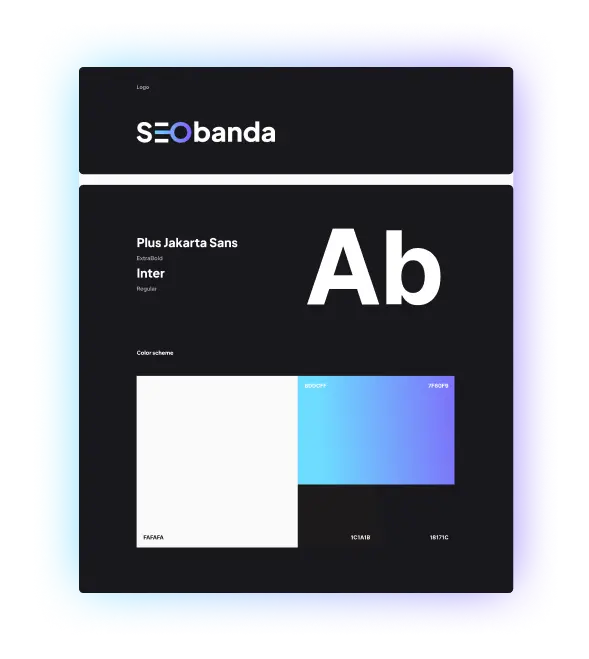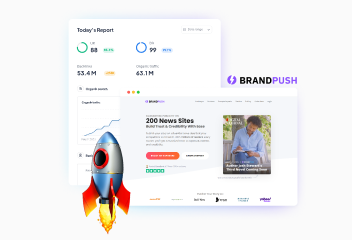Brand identity: The key to brand recognition and SEO success
Every product has its own unique feature that sets it apart from other brands. It could be a special font, a unique mascot, or an interesting logo with the right colors, but it all goes by one name – identity. What is brand identity? It is the definition of a brand’s personality. It is a comprehensive approach to developing a company’s visual identity, which is the “face” of the brand.



Why do you need an identity?
Brand identity emerged at the beginning of the twentieth century, when companies in the same industry began to appear that needed to be different from each other.
It is needed to develop a unique and recognizable brand image that distinguishes it from its competitors. It is a comprehensive approach to creating a visual and verbal identity for a company that covers all aspects of its presence in the market.


Identity Components
The branding identity consists of several key elements, each of which plays an important role in shaping the overall image of the company:
- Logo. The central element is undoubtedly the logo – the main symbol of the brand visual identity. There are different types of logos. A text logo consists only of the name in a special font. Graphic logos use a symbol or image without text, such as McDonald’s. Compound logos combine text and a graphic element to create a complete image.
- Typography. The correct choice of fonts used by a brand is very important. It includes both the main font for headlines and an additional font for the main text. Fonts not only ensure readability, but also reflect the character and values of the brand. For example, The New Yorker’s identity is a typeface, it is easily recognizable, and if you see it anywhere other than on a company product, it immediately evokes associations with the brand.
- Color palette. Color selection is another key element of brand identity. It consists of primary and secondary colors that evoke certain emotions and associations in the target audience. The right color scheme can significantly increase brand awareness. The most famous example of such an identity is Coca-Cola, whose distinctive red and white colors evoke various emotions such as passion, energy, and drive. This encourages potential consumers to buy their products and associate these colors with the brand.
- The mascot. This identity element has recently gained popularity compared to the others. Companies often create characters called mascots to connect with potential audiences. The mascot’s appearance, behavior, and attributes also help consumers associate the brand with the company. A well-known example in Ukraine is Foxtrot, whose mascot is a fox.

Increase visibility
for your business: SEO solution for growth!


Types of identity

In order to make it easier to understand how to create a brand identity, two types of identity have been developed: traditional and non-traditional. These are two different approaches that have their own features and advantages.
- Traditional identity
- Traditional identity is based on the unchanging principles of design and marketing. It is characterized by a clear structure and consistency. The main elements of traditional identity include: logo, fixed color palette, selected fonts, a set of graphic elements
- These components remain unchanged at all points of contact with the brand. The traditional approach ensures stability and brand recognition, which is especially important for large corporations and established brands.
- The advantages of a traditional identity are its reliability and predictability. It creates a strong, coherent brand image that is easily remembered by consumers. It is especially effective for companies seeking to inspire trust and emphasize their stability.
- Unconventional Identity
- On the other hand, unconventional identity departs from established norms and experiments with new forms of visual communication. It can be different. Instead of a fixed logo, unconventional identity may use a system of variable elements that change depending on the context, such as an animated logo or Google’s themed logos for different holidays.
- The benefits of unconventional identity, such as flexibility, allow for a more emotional connection with consumers and reflect the dynamic nature of modern business.
- An unconventional approach is often chosen by brands that want to stand out in the marketplace, emphasize their innovation, or appeal to a younger audience.


The psychology of identity
More and more companies are localizing their brands. This requires the adaptation of visual elements. The brand identity and its visual elements shape the perception of a brand on a subconscious level. Color evokes an emotional response: red excites, blue calms, green is associated with nature. Logo shapes convey the character of the brand: round outlines create a sense of friendliness, sharp corners – dynamism.
Typefaces influence the perception of messages. Serifs give text a classic look, while chopped fonts are modern. Type size and thickness define the hierarchy of information and control attention.
Warm colors encourage impulse buying, while cold colors create an atmosphere of reliability and professionalism.
You can also add cultural specifics, as a person is likely to be more positive about a brand that uses their culture in its products. Color can be seen as an important part of the cultural trait. For example, white is associated with purity in the West, while in some Asian countries it is associated with mourning.

Increase visibility
for your business: SEO solution for growth!


How identity affects SEO
- Identity increases brand awareness, which in turn increases click-through rates in search results. When users see a familiar logo or brand name in search results, they are more likely to click through to the website. This improves the click-through rate, which is an important factor for search engines. Consistent use of brand-related keywords in text and metadata also helps search engines better understand the site’s content.
- High-quality website design that is consistent with the brand identity improves the user experience. This leads to an increase in time spent on the site and a decrease in bounce rate, which has a positive impact on search engine rankings.
- A unique visual style can help create high-quality visual content that users want to share. This increases the number of backlinks, which is an important ranking factor. In addition, properly designed images with identity elements can improve the search engine optimization of images, which is an additional source of traffic.


Conclusion
Brand identity is a powerful tool that plays a key role in promoting and creating a unique brand image that resonates with the target audience. It is a complex process that combines creativity, strategic thinking and an analytical approach. Investing in identity development is investing in the future of the brand!
You may also like it

What is a dynamic URL and its impact on SEO
A dynamic URL (Uniform Resource Locator) is a web address that changes depending on the user's request or specific parameters. It differs from a static

Press releases as an important part of your SEO strategy: Brand Push Services
SEO is the best promotion on the Internet that helps attract more potential clients and improve your market position. The use of press releases is an important SEO...













